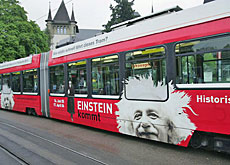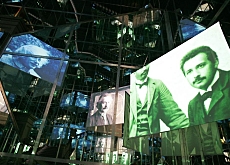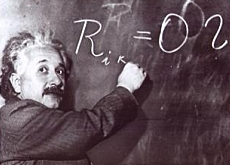Einstein exhibition attracts record visitors

The 350,000 visitors who flocked to the Bern exhibition on Albert Einstein have made it the country's most successful historical display ever, according to organisers.
“Einstein”, which has closed after a 16-month run, was set up exactly 100 years after the theoretical physicist came up with some of his most famous theories while living and working in the city.
In 1905 Einstein published a series of groundbreaking papers – including that on relativity – that changed the way the universe was considered.
The exhibition – with a budget of SFr7.2 million ($5.7 million) the largest ever on Einstein – documented his work as well as his complex life, while also providing some historical background.
The spectacle closed on Sunday, having already been extended by five months due to popular demand, and made a profit of SFr1.2 million, according to the museum.
Two-thirds of visitors came from outside canton Bern and 17 per cent travelled from abroad.
The influx of visitors, which was so great that adjustments had to be made to the entrance, remained constant over the 488 days, with an average of 717 entrants per day. The number even increased during the final days.
But those who missed the exhibition need not worry – from February 1, 2007 it can be seen in concentrated form as a permanent exhibition in the museum covering 1,200 square metres and containing many computer animations on Einstein’s physics.
Comprehensive
During the exhibition, Einstein’s life was shown through documents, letters, newspaper articles, photos and everyday objects, like his desk from the Swiss Patent Office in Bern, where he did most of his thinking while working as a clerk.
His turbulent marriages and his behaviour towards his children were also highlighted, as well as his Jewish origins, his relationship with Switzerland and the rest of the world, plus his opinions on war and social and economic issues.
The highpoint of the exhibition was the view from the museum tower room. From there, visitors could see where Einstein lived in Bern from 1902 to 1909.
In addition, 120 documentary videos put the scientist’s life into historical perspective, covering everything from the First World War to the creation of Israel.
The second part of the exhibition was devoted to Einstein’s work. Computer animations explained his revolutionary theories and their effect on our understanding of the universe.
swissinfo with agencies
Bern has been honouring physicist Albert Einstein (1879-1955) with a special exhibition at the city’s Historical Museum on the revolutionary discoveries he made while living in the Swiss capital.
The event opened at the Swiss capital’s Historical Museum on June 16, 2005 and ended on October 16, 2006.
The exhibition cost SFr7.2 million to set up and with 2,500 square metres of floor space, was the biggest Einstein exhibition ever.
Albert Einstein was born in Ulm, Germany, on March 14, 1879.
His family moved shortly afterwards to Munich, then to Italy and finally to Switzerland.
He continued his education in Aarau and in 1896 he entered Zurich’s Federal Institute of Technology to train as a maths and physics teacher.
In 1901 he became a Swiss citizen and a year later began working at Bern’s Patent Office.
In 1905 he produced five groundbreaking papers on theoretical physics.
In 1909 he took up a teaching position in Zurich and moved on to Prague in 1911.
Einstein died on April 18, 1955 in Princeton, New Jersey.

In compliance with the JTI standards
More: SWI swissinfo.ch certified by the Journalism Trust Initiative


You can find an overview of ongoing debates with our journalists here. Please join us!
If you want to start a conversation about a topic raised in this article or want to report factual errors, email us at english@swissinfo.ch.